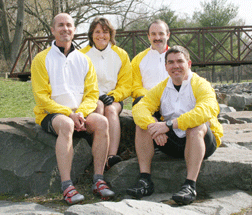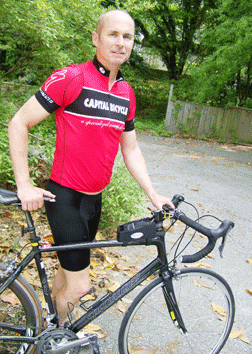Outracing CancerFour friends plan to pedal coast to coast in just one weekby Carrie Madren
|
 |
For seven days, Shuart, top left, and his three teammates — friends Jody Bennett, Stuart Levy and Steve ‘Buster’ Laurenson — will trade off hour-long sprints in this 3,000-plus-mile trek. |
“I realized that besides having a history with skin cancer, I also have a future with skin cancer,” says Shuart, who has been an outdoor athlete, a sailor, out on the ball fields and in Ocean City in the summer.
“As a child, I was unprotected in the sun, and now I’m paying the consequences,” he says.
Shuart started looking for races that would allow him to raise money for his cause, and saw that many of the Race Across America teams used it as charity fundraising rides.
“I thought, this fits — I can use my athletic skills to raise money,” he says. He joined forces with the Dermatology Nurses Association and Children’s Melanoma Prevention Foundation.
His message for this race is Protect your children now and they will benefit later.
“A sunburn at an early age will multiply effects much later on,” he says. “It’s fine to be active and outdoors, but do it safely.” That means wearing sun protection and staying out of the sun between the hours of 10am and 2pm, when the UV index is highest during the day.
To keep himself safe during his hours riding out in the sun, Shuart plans to slather on Neutrogena Suncare with Helioplex, a sunscreen with new UVA- and UVB-blocking technology equivalent to SPF 70. He and his team will also be donning sun-blocking jerseys and clothes from their sponsor Coolibar.
Part of the money the team raises will go to buy materials and lessons to teach sun smarts to kids. The short storybooks, placed in dermatology offices around the country, will teach students wise sun choices. One of the three books, Shuart says, is about a girl going to prom and deciding whether to get tanning sessions or put the money toward her prom dress.
To spread sun safety along the way, the Nurses’ Association will set up tables at a handful of checkpoints along the route to help teach communities and families. Shuart plans to reach out to Americans along the route, too, if he can.
“That’s what I can do,” he says. “I’m not a professional fundraiser; I’m a computer programmer and an athlete.”
 |
Shuart’s team is pedaling to break the race’s standing average speed: record of 15.4 miles per hour. |
Revving Up
This is Shuart’s, Bennett’s and Laurenson’s first cross-country trip; Levy’s fourth. All have competed in marathons, triathlons or adventure races. The foursome took on an experienced coach in December to help them prepare.
“Even then, we were starting from a high level of fitness,” Shuart says. “Our workouts were five days a week, and the sixth day was strength training; then one rest day.” Over time, riders increased their miles per week. A month before the race, Shuart averaged over 250 to 300 miles a week. By Memorial Day weekend, Shuart and teammates will start to taper down — easing up on their high-endurance training and resting up for the race. The week before, Shuart says he’ll be eating as much as he can as he rests, so he can start the race feeling 100 percent.
Training for ultra-distance riding is hard, but the biggest challenge, Shuart says, has been logistics.
“There’s so much to get ready to get this caravan across the country,” he says. “They say the hardest part of this race is getting to the starting line.” It seems true. Convincing 10 people to join the journey, securing all the equipment, securing vehicles and flying everyone out to California takes precise planning. Such careful coordinating has been the work of the last year, and he’s banking that it will pay off.
“Once I get on my bike, hopefully, my job is done,” he says.
Getting on the Road
Capital Bicycles, among the team’s sponsors, is lending Shuart a $6,000, carbon-fiber Specialized Roubaix bicycle, a much lighter, stronger bike than Shuart owns.
Will he get to hold onto it after the race is over?
“I think they do want it back for their fleet of demo bikes,” Shuart laments. Another sponsor, Coolibar UPF 50+ Sun Protective Clothing, will outfit Ride4Melanoma with sun protective jerseys on their journey. Other sponsors funding the race include Annapolis Dermatology Associates, Brainware Inc. and Caris Cohen DX.
With the race just weeks away, Ride4Melanoma is only halfway to its $100,000 fundraising goal. The figure will both pay for the sun awareness books and help get the team and their caravan across the country, not a cheap feat. Airfare, RV, cars, gas, food, pre race hotel, special light systems for the cars, and lots more adds up to $27,000, mostly paid by the four racers. Gas alone will cost them $1,000, Shuart figures. The race’s entry fee was $5,695 for a four-person team.
So far, $30,000 has come from both private donations and corporate sponsorships, plus an April fundraising ride that brought in some 70 riders and more than $3,000. Only a small portion of that $30,000 will go toward the team’s expenses.
There’s still time for the team to meet its fundraising goal, but if they don’t, Shuart says he will make up the difference from his own pocket.
He and team Ride4Melanoma already have a lot invested in the race, and he has asked friends and family to invest time, energy and money. That includes a year of planning and a long buildup.
As in planning a wedding or other huge event, the anticipation has been building with each detail Shuart coordinates.
He’s raring to go, he says,
“Mentally I’m ready … I’m like let’s just get going.”
Find out more about the Shuart’s team and how you can help at www.ride4melanoma.com. During the event, watch for racers on national television networks and for daily updates posted on www.raceacrossamerica.org. After the competition, stay tuned next month when Bay Weekly catches up with Shuart and his team for post-race reflections.



